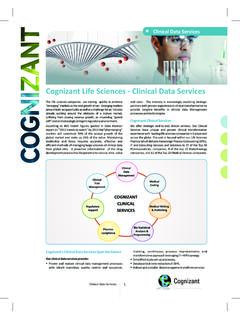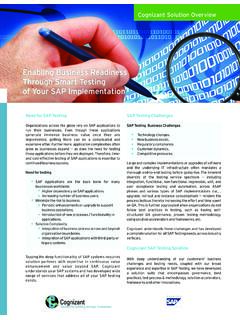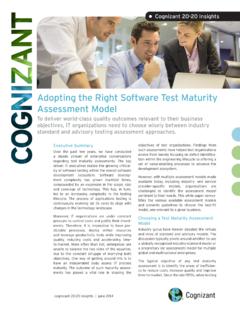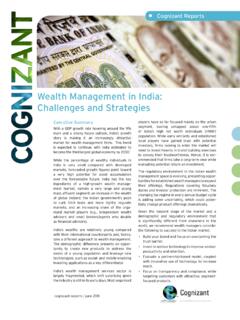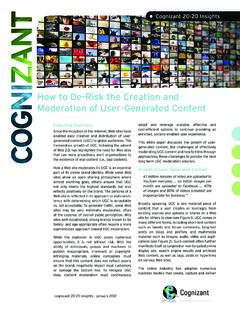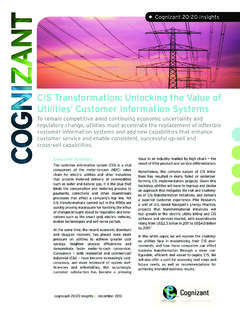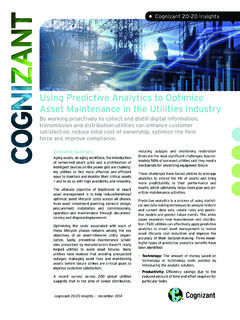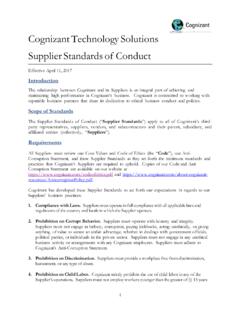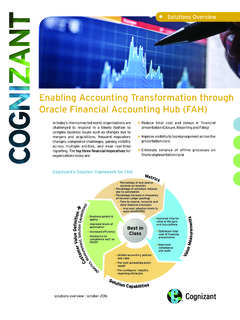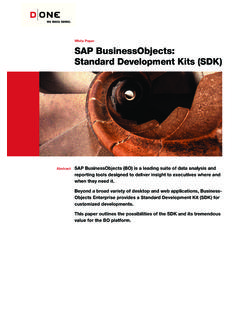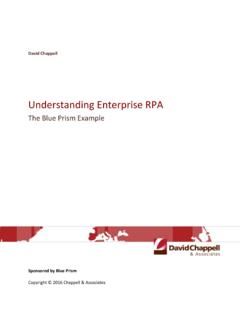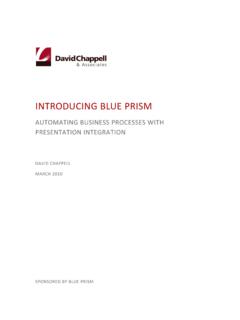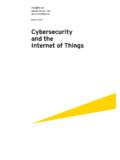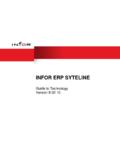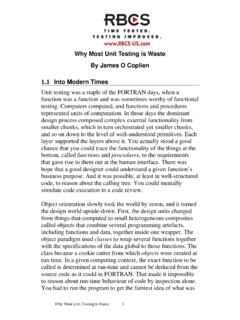Transcription of Architecture Standardization Using the IBM …
1 Architecture Standardization Using the IBM information Framework A standardized information model that leverages IBM s information Framework can prove useful in an enterprise-wide digital transformation project, as one of our clients, a Middle Eastern banking major, learned. Executive SummaryAs a part of its digital transformation journey, a Middle Eastern banking major wanted to create a service-based infrastructure, founded on a stan-dard-based information model, for its banking domain. This Standardization program spanned diverse technology platforms across all of its banking applications, including core banking systems and several other legacy systems built with many products and technologies. The IBM information Framework (IFW) was chosen as the preferred standard. This white paper describes the major architectural decisions undertaken as a part of this implementa-tion, the approach used and the learnings achieved at various stages of this journey, as well as some of the benefits our client realized along the 20-20 Insights | July 2017 COGNIZANT 20-20 INSIGHTSC ognizant 20-20 InsightsArchitecture Standardization Using the IBM information Framework | 2IN SEARCH OF A BETTER BANKING Architecture With a large customer base, this financial institu-tion has a presence in the United Arab Emirates, Singapore, India, China, Qatar and Libya.
2 It has operated with an average profit margin of over USD $1 billion for past few years. But the IT department of the bank has struggled to stream-line its IT processes and expand the business. The bank found it difficult to manage the complex web of legacy silos, disparate systems, redundant functionality, excess capacity and inconsistent service levels, and thus it operated in an envi-ronment noncompliant with service-oriented Architecture (SOA). Currently, the bank operates with a business structure under which its products are manufac-tured or developed internally. The bank typically incurred huge costs for IT support and main-tenance. Added to this, services were hardly reused. Without a regulatory mandate to comply with, and lacking any formal architectural gover-nance, the bank developed new services without validating whether a similar service had already been built.
3 This, in turn, increased the turnaround time for implementing business requirements, which, in turn, increased the organization s costs. As a result, there was very little flexibility to adapt to changing consumer requirements, regulations and marketplace demands. Thus, a major product rollout typically took an inordinate amount of time to fully implement across all lines of business and geographies, and quality was compromised as well. In order to survive in the competitive financial market, the bank needed to offer its customers differentiated products/services with shorter time to market. At the same time, the bank wanted to enhance its risk management and comply with the requirements of new directives and regulatory demands, such as Basel III. It had become difficult for the bank to live up to these expectations without a common enterprise Architecture (EA) framework, which required an enterprise-wide digital transformation key business objectives for this program included: Deliver a consistent customer experience across channels.
4 Create a service-based infrastructure to sup-port faster product and service rollouts and thereby enhance operational agility. Reduce IT costs to support disparate pro-cesses. Introduce best practices in an enterprise-wide fashion. Facilitate compliance efforts with policies and firm s Enterprise Architecture Review Board decided to use this opportunity to standard-ize its information Architecture by creating a service-based infrastructure governed by a common canonical model. The primary benefits expected from this digital transformation initia-tive included: Reduced time to market for new products/services as well as any updates in the existing application portfolio. A common blueprint for the overall frame-work for regulatory compliance as well as reengineering, broadening and standardizing core business processes or implementing new business process architectures.
5 Best practices and guidelines required to sup-port critical business issues and ensure that IT projects are linked with business require-ments. A means to help the bank identify, describe and structure all of the business functions, data and processes in an objective manner Cognizant 20-20 Insightsthat can be understood by both IT and busi-ness users. A streamlined, efficient organization where services are built once and reused many times across multiple lines of Architecture board reviewed several industry models and finally decided on IBM information of the Architecture Standard IBM IFW provides a set of data, process and ser-vice-based models focused on helping banks, brokerage houses and others in the financial services industry to accelerate the planning and requirements analysis of business process trans-formation and to ensure that IT projects are linked with business requirements.
6 Our client s other alternative was to build its own enterprise framework for the Architecture Standardization program. Building an enterprise canonical information and service model from scratch is a long-term endeavor and it requires significant costs, effort and a skilled workforce. Apart from this, it would divert the bank from its primary objective (digital transformation) and not engage in framework building. In this buy or build situation when there is a ready-made cost-effective solution available in the market, the architectural board opted to buy. IFW gained preference over any other alterna-tives for this Standardization program based on the following criteria: Alignment with principles from other leading frameworks such as Zachman and BIAN. Granular level business services, backed by technical artifacts ( , wsdls, xsds), which reduces functional design time and effort.
7 Ability to be customized and extended to cover the specific requirements of the orga-nization. Provision of a canonical model for informa-tion entities, and service models based on these is important to note that industry models do not provide an out-of-the-box solution to address all of the organization s key issues. IFW provides generic abstraction of the problem domain. The models provide the blueprints and standards upon which specific processes and supporting services and data structures can be constructed. Thus, with an industry standard core foundation, IFW adoption can help to rapidly revamp the core information and service model and build more specific coarse-grained services and Standardization Using the IBM information Framework | 3 THE TRANSFORMATION JOURNEYA rchitecture Standardization is by far one of the critical changes in the IT landscape of an organization.
8 It cuts across all departments and business units and impacts the entire orga-nization s IT workforce, including enterprise architects, solution architects, infrastructure architects, software developers, testers and project managers. At the outset of this digital transformation journey, enterprise architects laid out the foun-dation principles, frameworks and guidelines needed to proceed for this program. They took the initiative to create the business case and evangelized IT stakeholders and business on this change. The IT workforce of the organiza-tion was structured accordingly. Several teams were dismantled while several other new teams were formed. The finalized organization struc-ture is illustrated in Figure decisions, approvals and roadmaps were in place, existing business entities were mapped to the corresponding entities in the IFW canonical model.
9 IFW-compliant services were identified to address the needs of respective business func-tionalities. Moreover, attributes for respective IFW entities were also identified and mapped from the business attributes. Solution archi-tects, along with business analysts, carried out these activities. Figure 2, next page, details the relevant mapping between business and IFW entities included in this program. Architecture Standardization Using the IBM information Framework | 4 Architecture Standardization is by far one of the critical changes in the IT landscape of an organization. Organization StructureTEAMS Enterprise Architecture Design Team Build Team Testing Team BSG Team Business CIO BUILD THE BANK RUN THE BANK BAU WBG PROJECTS DIGITAL INITIATIVE PROGRAM Project 1 Project 2 Project n Enabled Figure 1 Cognizant 20-20 InsightsArchitecture Standardization Using the IBM information Framework | 5 For exposed vendor services that are not possi-ble to transform, IFW-compliant facade services were defined.
10 The implementation team, along with their respective application architects, performed the technology assessment and feasibility study to incorporate IFW in the orga-nization s existing IT landscape. They built the respective IFW domain objects and the relevant IFW-compliant services. Key elements of the technology stack used in this program included: Integration platform for hosting IFW-compli-ant services IBM Integration Bus v10. Importantly, IFW provides a technology- agnostic model, and does not impose any prejudice over the technology stack used; the same canonicals can be referred to for developing the services in other technol-ogy stacks as well. For service repository, service versioning and service lifecycle management IBM Web-Sphere Service Registry and Repository (WSRR). For service design IBM Rational Software Architect.
